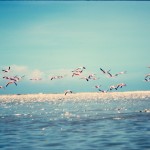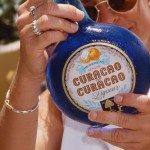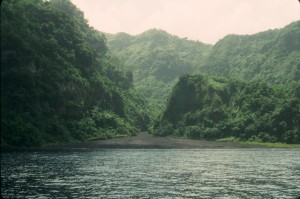20 Unique Caribbean Attractions

The spectacular Scarlet Ibis arrives nightly to roost in the Caroni Swamp Bird Sanctuary in Trinidad – Photo by Bjørn Christian Tørrissen, bjornfree.com
You already know that the islands of the Caribbean have beautiful beaches washed by gin-clear waters and shaded by swaying palms but what you might not know are some of the unusual attractions that make a given island special and unique and often as memorable as its beaches.
The Perfume Factory in Grand Bahamas (frequently known as Freeport, its main town) is set in a replica of an old Bahamian mansion, where scents for ladies and gents are made by Fragrance of the Bahamas. Guides dressed in period costumes give tours. There are six standard fragrances, but what’s unique and special is that you can create your own scent and registered it in your name. (www.perfumefactory.com)
 The Barbados Wildlife Reserve on the island of Barbados is a sanctuary for the green, or vervet, monkey, created by the Barbados Primate Research Centre, the only one of its kind in the Caribbean. When the West African monkeys became so numerous, the government asked the Centre to organize a humane trapping and management program. The monkeys, uncaged, can be seen in a mahogany grove along with agoutis and other animals and birds.
The Barbados Wildlife Reserve on the island of Barbados is a sanctuary for the green, or vervet, monkey, created by the Barbados Primate Research Centre, the only one of its kind in the Caribbean. When the West African monkeys became so numerous, the government asked the Centre to organize a humane trapping and management program. The monkeys, uncaged, can be seen in a mahogany grove along with agoutis and other animals and birds.
 Bonaire has a Flamingo Sanctuary in the 150 year old salt pans of the Solar Salt Works — a fine example of an industrial complex working in harmony with nature. Amid mountains of salt, hundreds of flamingo fly in daily from their roost in Venezuela to spend the day in the salt pans.
Bonaire has a Flamingo Sanctuary in the 150 year old salt pans of the Solar Salt Works — a fine example of an industrial complex working in harmony with nature. Amid mountains of salt, hundreds of flamingo fly in daily from their roost in Venezuela to spend the day in the salt pans.
The Baths on Virgin Gorda in the British Virgin Islands are a grotto created by toppled gigantic rocks different from any rock formation of the area. The enormous wind-worn rocks have fallen in such a way as to create labyrinths that are fun to explore. Where the sea rushes in, the formations catch the water, creating pools that shimmer from the sun filtering through the rocks.
 In the Cayman Islands just inside the barrier reef at North Sound on Grand Cayman is an unusual site dubbed Stingray City. In only 12 feet of water, divers can touch, feed and photograph a dozen or more Southern Atlantic stingray. The prehistoric creatures with eyes on top of their bodies have wing spans up to five feet and look like ships from outer space gliding gracefully through the water. Despite their frightening look, they are friendly and gentle with skin like velvet.
In the Cayman Islands just inside the barrier reef at North Sound on Grand Cayman is an unusual site dubbed Stingray City. In only 12 feet of water, divers can touch, feed and photograph a dozen or more Southern Atlantic stingray. The prehistoric creatures with eyes on top of their bodies have wing spans up to five feet and look like ships from outer space gliding gracefully through the water. Despite their frightening look, they are friendly and gentle with skin like velvet.
 The island of Curacao has given its name to an unusual orange‑flavored liqueur, Curacao, made from the Valencia orange planted there by the early Spaniards. In the island’s aridity and red clay soil, the trees bore a fruit too bitter to eat, but its oil proved suitable for making liqueur. Landhuis Chobolobo, an 17th century manor, houses Curacao Liqueur Distillery where it’s made and visitors are welcome.
The island of Curacao has given its name to an unusual orange‑flavored liqueur, Curacao, made from the Valencia orange planted there by the early Spaniards. In the island’s aridity and red clay soil, the trees bore a fruit too bitter to eat, but its oil proved suitable for making liqueur. Landhuis Chobolobo, an 17th century manor, houses Curacao Liqueur Distillery where it’s made and visitors are welcome.
In Dominica, a trail from the narrow Titou Gorge leads to the Valley of Desolation and the Boiling Lake, the world’s second largest solfatara lake. The Lake looks like a huge mist-covered caldron of bubbling grey‑khaki water. Thought to be a flooded fumarole, or hole in a volcanic region that releases hot gases and vapors of the molten lava below, it’s a tough four hour trek to reach it.
 In the southeast corner of the Dominican Republic, Casa de Campo resort has an art and design center, Altos de Chavon, that is unique in the Caribbean. In association with Parson School of Design in New York which provides scholarships, artists-in-residence and other aid, the center offers an accredited curriculum to Caribbean students along with the opportunity to study in New York.
In the southeast corner of the Dominican Republic, Casa de Campo resort has an art and design center, Altos de Chavon, that is unique in the Caribbean. In association with Parson School of Design in New York which provides scholarships, artists-in-residence and other aid, the center offers an accredited curriculum to Caribbean students along with the opportunity to study in New York.
Grenada’s sister island of Carriacou is famous throughout the Caribbean for its Big Drum Festival in August. It’s part of the Carriacou Regatta, one of the Grenadines’ main sailing events, when all types of boats ‑‑ work boats, sloops, schooners miniatures — participate. Banana boats exchange their cargo for people and sailors converge on the island for three days of festivities with the Big Drum Dance, an African ritual dance, the biggest event.
 The French island of Guadeloupe celebrates its cooks and cuisine with the colorful Fete des Cuisinieres (Festival of the Women Cooks) held in August on the feast day of St. Laurent, patron saint of cooking. For days, the women cooks of the island prepare their specialties and make their costumes. The celebration starts with a High Mass at the Cathedral in Pointe‑a‑Pitre to bless the food. Afterwards, the women in their Creole finery parade through the streets carrying their decorated plates to a nearby school where the party begins.
The French island of Guadeloupe celebrates its cooks and cuisine with the colorful Fete des Cuisinieres (Festival of the Women Cooks) held in August on the feast day of St. Laurent, patron saint of cooking. For days, the women cooks of the island prepare their specialties and make their costumes. The celebration starts with a High Mass at the Cathedral in Pointe‑a‑Pitre to bless the food. Afterwards, the women in their Creole finery parade through the streets carrying their decorated plates to a nearby school where the party begins.
In Jamaica, Rafting on the Rio Grande began as a Port Antonio pastime in 1911, when a United Fruit Company representative got the idea after watching bananas being towed by raft downstream to the loading docks. But it was actor Errol Flynn who popularized it by launching the first rafters’ race. Over the years, it has become one of Jamaica’s most popular excursions. The trip starts upstream where passengers board a 30‑foot‑long bamboo raft which seats two. With the Blue Mountains in the background, an experienced helmsman guides the raft leisurely down the Rio Grande while passengers enjoy the river’s beautiful tropical setting.
St. Pierre, known as the Pompeii of the Caribbean was the fashionable capital of Martinique until it was devastated by the eruption of volcanic Mt. Pelee in 1902 when burning gas and ash rained down it. In minutes the entire population of 30,000 perished, except for one, a prisoner protected by his underground cell walls. St. Pierre Town Museum is a poignant memorial; clocks on display ‑‑ all stopped at the same time ‑‑ mark the moment.
 About 30 minutes east of San Juan, Puerto Rico, the Caribbean National Forest, commonly known as El Yunque, is the only tropical rain forest in the U.S. Forest Service system. Long a research center on tropical flora and fauna, El Yunque has trails leading to waterfalls and recreation areas and is one of the island’s most popular destinations.
About 30 minutes east of San Juan, Puerto Rico, the Caribbean National Forest, commonly known as El Yunque, is the only tropical rain forest in the U.S. Forest Service system. Long a research center on tropical flora and fauna, El Yunque has trails leading to waterfalls and recreation areas and is one of the island’s most popular destinations.
The island of Saba, itself, is unique. Situated southwest of St. Maarten, the cone‑shaped volcanic peak rises straight up from the sea to 3,000 feet. It has no flat land and no beaches. In the 1930’s when Dutch engineers said constructing a road on the steep terrain was impossible, a local resident proved them wrong. He organized the citizens who hand‑laid the road that zigs and zags up the mountainside to The Bottom and Windwardside, Lilliputian villages of gingerbread houses with white fences. Except for the tropical gardens, you could more easily imagine yourself on the set for Hansel and Gretel than on a Caribbean island.
 Like signposts in the Caribbean, St. Lucia’s Pitons — Petit Piton, 2,438 ft., on the north and Grand Piton, 2,619 ft., on the south — are ancient volcanic spikes, which rise at the water edge to over twice the height of the Eiffel Tower in Paris. The view of the sugarloaf twins is magnificent from hilltops above Soufriere and mystical at sunset when the peaks are bathed in the color-filled light of the setting sun.
Like signposts in the Caribbean, St. Lucia’s Pitons — Petit Piton, 2,438 ft., on the north and Grand Piton, 2,619 ft., on the south — are ancient volcanic spikes, which rise at the water edge to over twice the height of the Eiffel Tower in Paris. The view of the sugarloaf twins is magnificent from hilltops above Soufriere and mystical at sunset when the peaks are bathed in the color-filled light of the setting sun.
St. Maarten/St. Martin, the unique combination, offers you two islands and two cultures for the price of one. Dutch St. Maarten and French St. Martin are two countries without borders. You can tell you are crossing from one to the other only by a welcome sign. Yet they are definitely different — in style, language, people and ambience.
 A remarkable phenomenon of St. Vincent’s volcanic eruptions are the “dry rivers” — river beds filled and choked with scoriae, or lava cinder. Water flowing into the river seeps through the scoriae and disappears, becoming a subterranean river as it nears the coast. At the mouth of the river, the surface is bone dry.
A remarkable phenomenon of St. Vincent’s volcanic eruptions are the “dry rivers” — river beds filled and choked with scoriae, or lava cinder. Water flowing into the river seeps through the scoriae and disappears, becoming a subterranean river as it nears the coast. At the mouth of the river, the surface is bone dry.
On the island of Trinidad within the mangroves south of its capital,

Scarlet Ibis – Photo by Bjørn Christian Tørrissen, www.bjornfree.com
Port of Spain, is found the 450-acre Caroni Bird Sanctuary, the home of the gorgeous scarlet ibis, Trinidad’s national bird. The return of the brilliant red birds at eveningtide has been called by Audubon “the most spectacular exhibition in the avian world.” As the sun drops in the sky, the birds arrive by the hundreds loudly flapping their three foot span of wings as they swoop down to perch on mangrove trees to roost for the night. Boat trips depart daily from the entrance to the mangroves.
On Grand Turk, the Turks and Caicos Islands National Museum, housed in the former “Guinep House,” one of the island’s oldest buildings, has a 65-foot caravel built before 1513. Known as the Molasses Reef Wreck, it is the oldest authenticated European shipwreck discovered in the New World.
Sandy Point National Wildlife Refuge on the southwest tip of St. Croix in the U.S. Virgin Islands is one of only two nesting grounds for the leatherback turtle in the United States. From March to June, the huge leatherbacks ‑- up to 6 feet in length and 1,000 pounds in weight -‑ come ashore to lays their eggs and lumber back to the sea, returning to repeat the ritual up to six times during nesting season. Two months later in the early dawn, the hatchlings emerge and dash to the sea.
© By Kay Showker

Leave a Reply